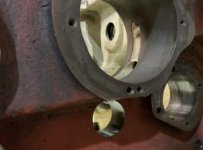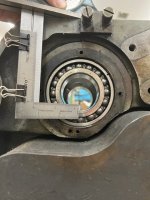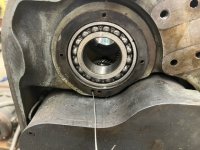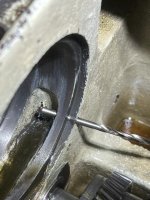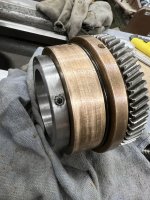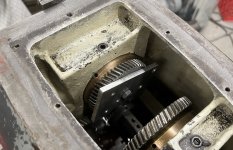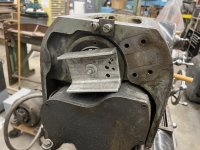ee_chris
Aluminum
- Joined
- Apr 9, 2003
- Location
- Derwood, MD
Hi all,
I have the spindle out of my 1946 10ee in order to apply sealant under the EE-2888 bushing and reinstall. Oil was leaking pretty quickly from the left bearing compartment to the center one. Many thanks to everyone who posted info here on spindle removal. I attached a photo of part of drawing 202268, which I believe is correct for this machine.
It isn't clear to me what the next steps are. Some specific questions:
1. Just to confirm, the best fix for this leak is to remove EE-2888 and apply sealant between it and the headstock. Correct? The remaining questions assume this is the case.
2. The gear that rides in EE-2888 (EE-2110) looks from the drawing to be retained by a ring held on the gear by set-screw(s). So EE-2888 has to come out with the gear in it? If this is the case, does the idler gear below interfere, and if so how do you get it out of way? And should the selector fork (EE-1102) also be removed?
3. I've read the rear bearings shouldn't be removed until after EE-2888 is out, and I'd prefer not to touch them at all. If so, how do you extract EE-2888? The shoulder is in a counterbore, and its ID is larger than the ID of the rear bearing. The retaining set-screw in top was already removed, and with a pin-punch in the oiling hole I can wiggle the bushing in rotation already. Should it just slip out?
4. Is EE-2888 located such that it can be reinstalled and the sealant allowed to cure before the spindle goes back in? Or does the spindle have to be reinstalled before the sealant sets so the gear and bushing self-center on the spindle?
I would really appreciate some guidance from folks who have been through this before. I am hoping to fix the leak without creating any new problems.
Thanks,
Chris
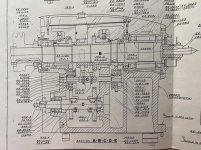
I have the spindle out of my 1946 10ee in order to apply sealant under the EE-2888 bushing and reinstall. Oil was leaking pretty quickly from the left bearing compartment to the center one. Many thanks to everyone who posted info here on spindle removal. I attached a photo of part of drawing 202268, which I believe is correct for this machine.
It isn't clear to me what the next steps are. Some specific questions:
1. Just to confirm, the best fix for this leak is to remove EE-2888 and apply sealant between it and the headstock. Correct? The remaining questions assume this is the case.
2. The gear that rides in EE-2888 (EE-2110) looks from the drawing to be retained by a ring held on the gear by set-screw(s). So EE-2888 has to come out with the gear in it? If this is the case, does the idler gear below interfere, and if so how do you get it out of way? And should the selector fork (EE-1102) also be removed?
3. I've read the rear bearings shouldn't be removed until after EE-2888 is out, and I'd prefer not to touch them at all. If so, how do you extract EE-2888? The shoulder is in a counterbore, and its ID is larger than the ID of the rear bearing. The retaining set-screw in top was already removed, and with a pin-punch in the oiling hole I can wiggle the bushing in rotation already. Should it just slip out?
4. Is EE-2888 located such that it can be reinstalled and the sealant allowed to cure before the spindle goes back in? Or does the spindle have to be reinstalled before the sealant sets so the gear and bushing self-center on the spindle?
I would really appreciate some guidance from folks who have been through this before. I am hoping to fix the leak without creating any new problems.

Thanks,
Chris

Attachments
Last edited:



